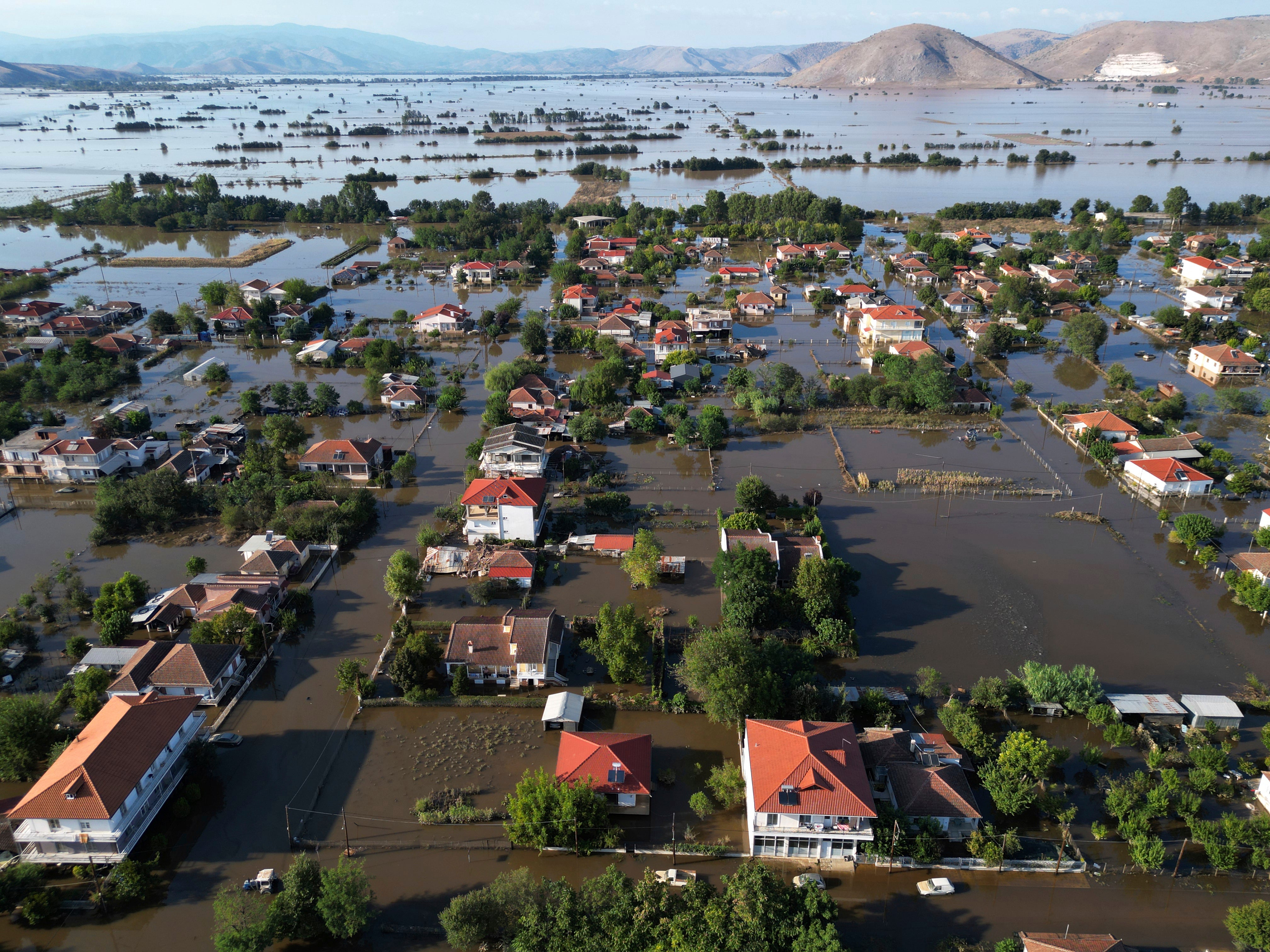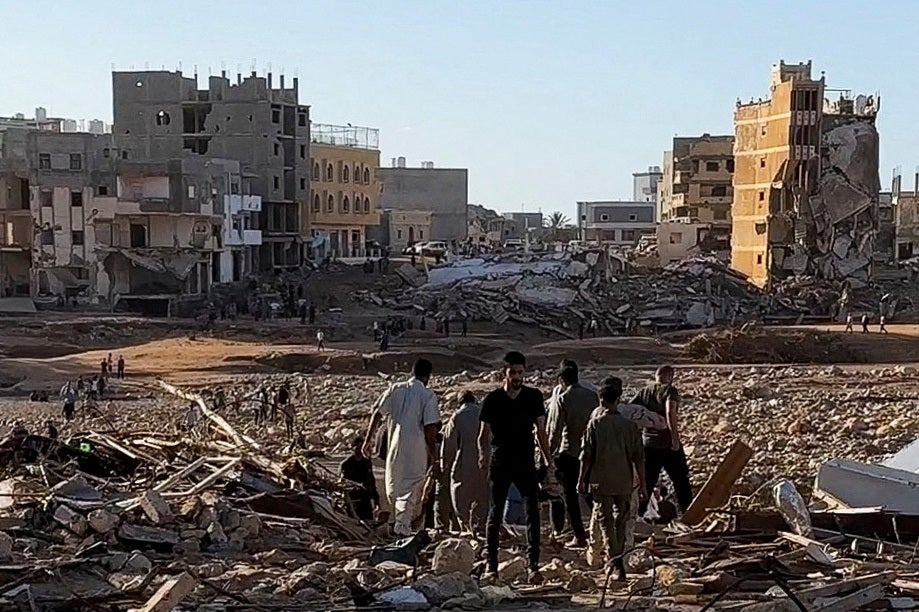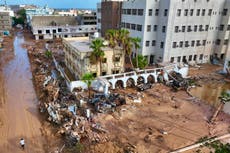Satellite images show scale of Libya devastation as mass graves used to bury dead
More than 1,500 corpses collected, half of them buried as of Tuesday evening
Satellite images showed the vast extent of damage due to one of the worst floods in Libya’s history as emergency workers uncovered hundreds of bodies buried in mass graves in the eastern city of Derna.
Authorities fear that the death toll could surpass 5,000 after floodwaters smashed through dams, washing away entire neighbourhoods, reported Associated Press, citing local officials.
Outside help was only just starting to reach Derna on Tuesday, more than 36 hours after disaster struck.
Footage showed a mass grave piled with bodies. More than 1,500 corpses were collected, and half of them had been buried as of Tuesday evening, the health minister for eastern Libya said.
The state-run news agency quoted Mohammed Abu-Lamousha, a spokesperson for the east Libya interior ministry, as saying that more than 5,300 people had died in Derna alone. Derna’s ambulance authority said earlier Tuesday that 2,300 had died.
At least 10,000 people are still missing, said Tamer Ramadan, Libya envoy for the International Federation of Red Cross and Red Crescent Societies. He said later on Tuesday that more than 40,000 people have been displaced.
With many bodies still believed to be trapped under rubble or being washed into the Mediterranean Sea, the official death count is expected to go up as the Libyan officials urged the international community for more support.

Rescue workers were still searching for victims, said Mohammed Qamaty, a volunteer in Derna.

"We call on all the young Libyans, anyone who has a degree or any medical affiliation to please come and help us," he told Reuters news agency. "We have a shortage in nurses, we need help."
Reuters journalists saw many bodies laid out on the ground in the hospital corridors. As more bodies were brought to the hospital people looked at them, trying to identify missing family members.
"Bodies are lying everywhere – in the sea, in the valleys, under the buildings," Hichem Abu Chkiouat, minister of civil aviation in the administration that controls the east, told Reuters by phone shortly after visiting Derna.
Videos posted online by residents showed large swaths of mud and wreckage where the raging waters had swept away neighborhoods on both banks of the river. Multi-storeyed apartment buildings that once were well back from the river had facades ripped away and concrete floors collapsed. Cars lifted by the flood were left dumped on top of each other.
In Derna, Mostafa Salem, 39, said he had lost 30 of his relatives. "Most people were sleeping. Nobody was ready," Mr Salem told Reuters.
Raja Sassi, 39, survived the flood with his wife and small daughter after water had reached an upper floor, but the rest of his family died, he said.
"At first we just thought it was heavy rain but at midnight we heard a huge explosion and it was the dam bursting," he said.
At Tripoli airport in northwest Libya, a woman wailed as she received a call saying most of her family were either dead or missing. Her brother-in-law, Walid Abdulati, said: "We are not speaking about one or two people dead, but up to 10 members of each family dead."
Karim al-Obaidi, a passenger on a plane from Tripoli to the east, said: "I have never felt as frightened as I do now ... I lost contact with all my family, friends and neighbours."

Red Crescent teams from other parts of Libya also arrived in Derna on Tuesday morning but extra excavators and other equipment had yet to get there.
The destruction came to Derna and other parts of eastern Libya on Sunday night. As the storm pounded the coast, Derna residents said they heard loud explosions and realized that dams outside the city had collapsed. Flash floods were unleashed down Wadi Derna, a river running from the mountains through the city and into the sea.

Residents say the only indication of danger was the loud sound of the dams cracking, with no warning system or evacuation plan.
The wall of water "erased everything in its way," said one resident, Ahmed Abdalla. “At least 20 percent of the city has been destroyed,” the deputy mayor of Derna, Ahmed Madroud, told Al Jazeera.
The Tripoli-based government of western Libya sent a plane with 14 tons of medical supplies and health workers to Benghazi.
It also said it had allocated the equivalent of $412m for reconstruction in Derna and other eastern towns.
Airplanes arrived Tuesday in Benghazi carrying humanitarian aid and rescue teams from Egypt, Turkey and the United Arab Emirates. Germany, France and Italy said they also were sending rescue personnel and aid.
Joe Biden said in a statement on Tuesday that the United States is sending emergency funds to relief organizations and coordinating with the Libyan authorities and the UN to provide additional support.
"Jill and I send our deepest condolences to all the families who have lost loved ones in the devastating floods in Libya," the US president said.
While flooding is common in Libya during the rainy season, there are concerns about how the rains were able to burst through two dams outside Derna.
Karsten Haustein, a climate scientist and meteorologist at Leipzig University, said in a statement that Daniel dumped 440mm (15.7 inches) of rain on eastern Libya in a short time.
"The infrastructure could probably not cope, leading to the collapse of the dam," he said, adding that human-induced rises in water surface temperatures likely added to the storm’s intensity.
Additional reporting from the agencies
Join our commenting forum
Join thought-provoking conversations, follow other Independent readers and see their replies
Comments


Bookmark popover
Removed from bookmarks